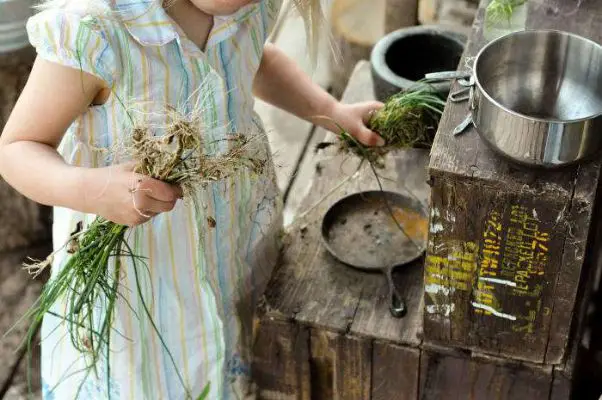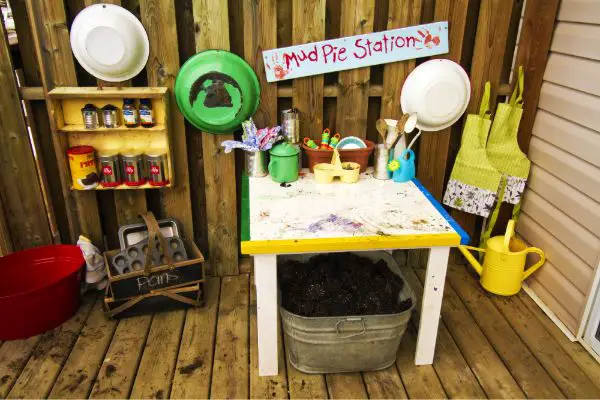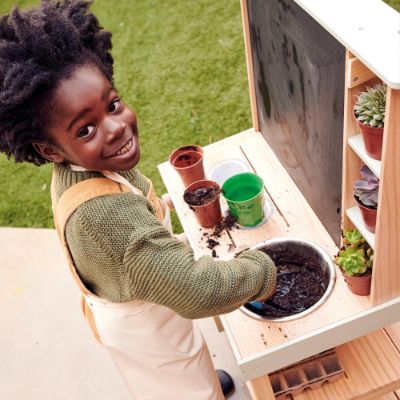Welcome to our comprehensive guide on creating a delightful mud pie kitchen—an engaging outdoor activity designed to ignite your child’s imagination, promote hands-on play, and foster a deeper connection with nature. Beyond the fun and messy experiences, this creative endeavor offers a unique opportunity for your little ones to develop essential skills while basking in the joys of childhood.
Throughout this blog post, we’ll provide a detailed step-by-step outline, ensuring that setting up a mud pie kitchen in your backyard or outdoor space becomes a seamless and rewarding project. From selecting the ideal location, gathering essential supplies, and designing the perfect layout, to sourcing the finest mud and equipping the kitchen with utensils, we’ve got you covered.

Safety and hygiene are paramount, and we’ll discuss ways to ensure a secure environment for your kids to play freely. Additionally, we’ll explore how to encourage imaginative play, incorporate educational elements, and even maintain and clean the mud pie kitchen for lasting enjoyment.
So, roll up your sleeves, embrace the merriment of mud, and embark on this enchanting journey of creating a mud pie kitchen. This endeavor promises endless laughter, learning, and unforgettable memories with your little ones.
Read More About How To MAke Wind Chimes
How Do You Build DIY Mud Kitchen For Kids? – Step-By-STep Guide
Building a DIY mud kitchen for kids can be fun and rewarding. A mud kitchen provides a great opportunity for children to engage in imaginative play, sensory exploration, and outdoor learning. Below is a step-by-step guide to help you create a simple and enjoyable mud kitchen for your little ones:
At Home Or Minecraft

Step 1 – Choose the Location
Select a suitable outdoor area for the mud kitchen in your backyard or garden. Ensure it’s flat, easily accessible, and offers some shade to protect the kids from the sun.
Step 2 -Gather Materials and Tools
Collect the necessary materials and tools. Here’s a basic list to get you started:
- Wooden pallets or scrap wood for the structure
- Wooden planks for shelves and countertops
- Nails, screws, and a hammer or drill
- Outdoor paint or wood stain (optional)
- Old pots, pans, and utensils
- Containers for mud and water play
- Hooks or pegs for hanging utensils
- Small sink or basin (optional)
Step 3 – Design the Mud Kitchen
Sketch out a simple design for your mud kitchen. You can create a basic structure using wooden pallets as the back and sides, wooden planks as the shelves as back and sides, and wooden planks as the shelves and countertops. Keep the design child-sized so it’s easily accessible and safe for them.
Step 4 – Construct the Mud Kitchen
Assemble the mud kitchen using wooden pallets and planks. Using nails or screws to secure the pieces creates the main structure. Make sure it’s stable and safe for kids to play around.
Step 5 – Add Shelves and Countertops
Attach the wooden planks to the inside of the structure to create shelves and countertops. These will serve as workstations for the mud kitchen. You can have multiple levels for different play areas.
Step 6 – Paint or Stain (Optional)
If you want to add a pop of color or protect the wood from the elements, you can paint the mud kitchen using outdoor paint or stain. Choose child-friendly colors to make it more appealing to kids.
Step 7 – Set Up the Play Area
Arrange old pots, pans, and utensils on the shelves and countertops. Hang hooks or pegs for easy access to utensils. Add containers or basins for holding mud and water.
Step 8 – Create a Mud Pit
Designate an area beside the mud kitchen as the mud pit. Dig a shallow pit and mix soil with water until it forms a nice mud consistency. Kids can use this mud for their play.
Step 9 – Personalize the Mud Kitchen
Encourage kids to decorate and personalize their mud kitchen with artwork, such as handprints or drawings. This adds a special touch and makes it feel truly their own.
Step 10 – Supervise and Play
Once the mud kitchen is ready, it’s time to let the kids play! Always supervise their play, encourage creativity, and join in the fun. Remember to emphasize the importance of handwashing after playtime.
What Materials Are Used In A Mud Kitchen?
| Material | Explanation | Uses | Alternative |
| Mud | A mixture of soil and water | For mud pies and various recipes | Clay, sand, or dirt |
| Water Containers | Small pots or basins to hold water for mud preparation | Mixing mud and adding desired consistency | Plastic bowls or buckets |
| Utensils | Old kitchen tools (spoons, cups, bowls) | Stirring, scooping, and serving mud dishes | Wooden sticks or stones |
| Table/Base | A low table, wooden pallet, or cardboard box | A platform for arranging mud kitchen items | Sturdy cardboard |
| Rocks | Natural elements for decorating and enhancing creativity | Decorative purposes | Sticks or pebbles |
| Leaves | Natural materials for adding texture and visual appeal | Imaginative play and decoration | Flowers or twigs |
| Water | Additional liquid for mud consistency adjustments | Achieving desired mud texture | None (add more soil) |
What Mud Do You Use For A Mud Kitchen?

For a mud kitchen, you typically use a mixture of soil and water to create the mud. The soil used can vary depending on what’s available in your area, but generally, any garden soil or topsoil works well. The soil should be free from harmful chemicals or contaminants, so avoiding using soil from areas treated with pesticides or other chemicals is essential.
Mix the soil with water to create the mud until you achieve the desired consistency.
The soil-to-water ratio can be adjusted to make the mud thicker or runnier, depending on the kids’ preferences and the activities they want to engage in. The consistency should be similar to a thick paste, making it easily moldable and workable for their mud kitchen play.
The mud provides a fantastic sensory experience for kids, allowing them to explore different textures and engage in imaginative play. They can pretend to cook mud pies, create mud cakes, and engage in other creative activities while learning about nature and enjoying the great outdoors.
What Are The Rules For A Mud Kitchen?
Rules for a mud kitchen may vary depending on the specific setting and age group of the children involved. However, the following are some common rules to ensure safety and enjoyable play:
- Before and after playing in the mud kitchen, children should wash their hands thoroughly with soap and water to maintain hygiene.
- Encourage kids to wear old clothes that can get dirty, as mud play can be messy.
- Children should be reminded not to throw mud at each other or use it inappropriately.
- Establish boundaries for the mud kitchen play area and ensure children stay within those limits.
- Check that all utensils and items used in the mud kitchen are safe and free from sharp edges.
- Remind children that the mud in the mud kitchen is only for play and should not be consumed.
- Encourage cooperative play and sharing of utensils and play space with other children.
- Running in the mud kitchen area can lead to accidents, so children should walk carefully.
- After finishing playtime, children should help clean up the mud kitchen area and put away the utensils.
- Ensure adult supervision at all times to maintain safety and intervene if necessary.
FAQs
What is the best soil for mud?
Ideal mud for play is loamy soil, with a mix of sand, silt, and clay. This balanced texture allows for smooth and malleable mud, perfect for various imaginative creations. Garden soil or topsoil also works as long as it’s chemical-free.
How is mud water made?
Mud water combines water with soil or dirt, creating a liquid mixture with a muddy texture. Add water to the soil and stir until the desired consistency is achieved. Depending on the intended use, the amount of water added can be adjusted to make the mud water thicker or more runny.
What makes mud sticky?
Mud becomes sticky due to the presence of clay particles in the soil. When water is added, it forms a thin film around the clay particles, creating the sticky texture.
Why is mud kitchen good for children?
A mud kitchen is good for children because it promotes sensory exploration, imaginative play, nature connection, fine motor skill development, social skills, stress relief, and environmental awareness. It offers a safe and enjoyable way for children to learn and have fun outdoors.
